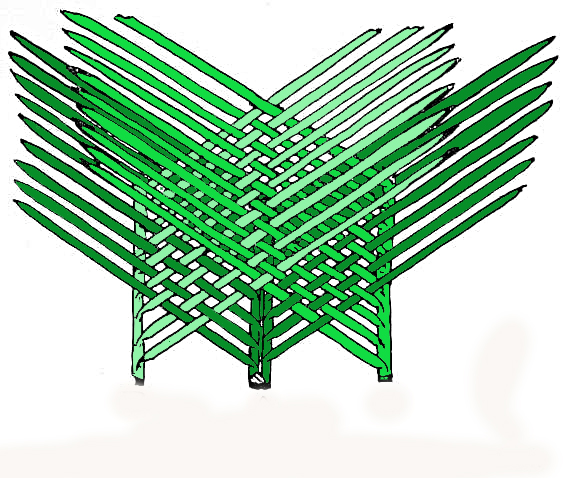
In Part 1 of this series of articles, I discussed the architectural records of foreign visitors to the Maldives. Part 2 was dedicated to a discussion of traditional lineal measures. In this Part 3, an outline of major shelters of the Maldives is given, together with the construction details of basic huts. Substantial shelters deserving of the term “homes” are discussed in Part 4.
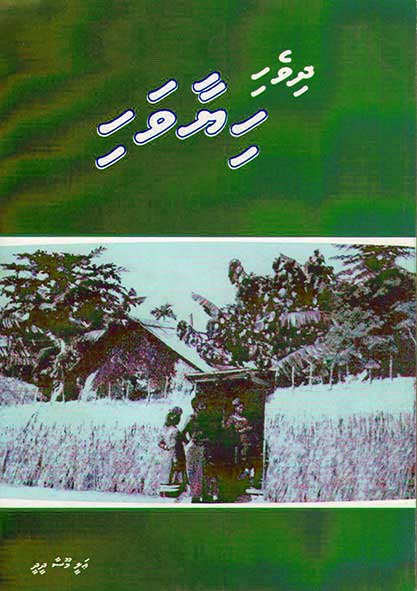 There are not many books written on Maldivian architecture of the past. In fact, I have come across only two. The first one was written by Ali Moosa Didi, a former contractor and a historian. His book entitled, “Dhivehi Hiyaavahi,” briefly discusses 45 types of Maldivian shelters. The book was published in 2011 by Novelty Printers and Publishers. The author outlines each of the structures in one half or a full page of an A5 sized book (73 pages). The other book is entitled “Dhiveheenge Dhiriulhun”. It is written by a well known author of literary works named Adam Abdul Rahman. The book, published in 2013 by the same publisher, devotes a few pages to the construction of traditional house in the context of Maldivian material culture. A recourse to this publication will be made in Part 4.
There are not many books written on Maldivian architecture of the past. In fact, I have come across only two. The first one was written by Ali Moosa Didi, a former contractor and a historian. His book entitled, “Dhivehi Hiyaavahi,” briefly discusses 45 types of Maldivian shelters. The book was published in 2011 by Novelty Printers and Publishers. The author outlines each of the structures in one half or a full page of an A5 sized book (73 pages). The other book is entitled “Dhiveheenge Dhiriulhun”. It is written by a well known author of literary works named Adam Abdul Rahman. The book, published in 2013 by the same publisher, devotes a few pages to the construction of traditional house in the context of Maldivian material culture. A recourse to this publication will be made in Part 4.
The shelters discussed in the book, Dhivehi Hiyaavahi, are listed below.
| Shelter name | Description |
|---|---|
| Hithige | A temporary elaborate and decorated shelter built for the king when he visited cenotaphs and tombs at certain times of the year. The shelter is about 15 riyan by 10 riyan. |
| Haruge | Any shelter built for a temporary purpose in suitable sizes for a particular need. For example, boats are built in haruge; and mauloodh are recited in haruge. |
| Han'dhubalaage | A temporary shelter built for moon sighting on the western side of an island just before the beginning and end of ramazan. The moon sighters (seekers) eat and drink in the shelter until the sighting is finished. |
| Hurage | Local name for a jail. Not always purpose-built. |
| Ban'daha | Fishermen's temporary quarters in an uninhabited island while on a long fishing trip. The shelter is about 12 riyan long and 7 riyan wide. The name is also used to refer to temporary shops and stores within the palace from which "ban'du hadoo" was distributed. |
| Ban'dahage | A store for food. Usually separate but pantries adjoining kitchen were common. |
| Beru fiyafaalhi | A temporary store for drummers and musicians. In rainy weather, these shelters were built near venerated tombs during hithi. |
| Bileh kafaage | A shelter in the palace where betel and arecanut preparations were made for feasts. |
| Badhige | Kitchen. Dimensions were 6 riyan by 4 riyan in typical homes. The kitchens of the well to do are, of course, larger. |
| Baiy fiyafaalhi | A temporary large kitchen built to 8 riyan or 10 riyan square for bodu mauloodh and samaa. |
| Boanuge | Nissen hut. A shelter with a semicircular roof which comes down to the ground level. This type of stores were temporary warehouses built after 1900. |
| Binmatheege | Public works shelter in Male'. |
| Badibeysge | A store for gunpowder in forts. The stores are usually metal sheet covered with an area of 7 riyan x 9 riyan. |
| Kulhibalaage | A roofed elevated structure for womenfolk to watch street parades from inside their plots. |
| Kievelige | A shelter about two to three riyan square built on futtaru side of islands on lagoon for recitation of special prayers when pestilence or hard times befall. The shelter is accessed from a small jetty. Futtaru is the side of the island on which large waves break on the beach. |
| Kullaabuge | A building within the palace quarters for special events especially for circumcision of children of royal blood. The sides are the ceiling are covered in embroidered cloth. |
| Kan'buruge | The state blacksmithy for producing war tools, weapons, etc. |
| Koalaage | Watchtower on a fort. |
| Koshaaru | A storage shelter usually four to five riyan long, two to three riyan wide and four riyan high. |
| kan'boage | A shelter built for keeping coal built on the Eastern side of Male' by an English company in 1883. |
| Ashige | A meeting place built on islands for elders. The shelters were used for women to recite prayers. Later, a larger ashige in Male' was used as a jail. |
| Odiharuge | A shed for building and maintenance of a fishing craft or freighter. |
| Anbalange | A shelter built on the Southern side of a house for womenfolk to gather or to carry out special tasks. |
| Un'dhoalige | A shelter for a swinging bed. This shelter may be on the front and the back of the house. If the shelter is on both sides, the back shelter is used by women. The shelter is used as a space for conversation with visitors or rest. |
| Atharuge | A perfumery within the palace. |
| Aakoatteymathige | A special meeting/living area built atop a fort in front of the palace in Male'. |
| Oleege | A temporary hut with thoshali roof and sides. Such huts were also built near a grave for recitation of prayers. The prayers are made for seven hours. It may be longer. |
| Edhuruge | A makthab for teaching elementary education. The makthab may be a porch or a separate building. |
| Vakaruge | An orphanage. Originally a store for coconut lumber. |
| Maaloodhu haruge | A shelter for mauloodh or benedictions and prayers. These shelters are often very well made and are open on all sides. |
| Mih'uraabuge | A section within a mosque where the imaam leads the prayer. |
| Maizaange | A public meeting shelter open on one or more sides. The shelter is about 12 riyan long and 8 riyan wide. |
| Mariyaadhuge | A shelter built for conversation and meeting people. These are built within the plot of land a house stands. |
| Moodhuge | A shelter built on lagoon. Such shelters may be for storage or temporary accommodation. |
| Fiyafaalhi | A temporary shelter built by the shipwrecked or by very poor people. |
| Fenfiyafaalhi | A kitchen for water heating for delivery and the succeeding nine days. This is a temporary shelter about three riyan wide and five riyan long. |
| Feylige | Tent. |
| Dharubaaruge | A marquee for official functions. |
| Dharufiyafaalhi | A store for firewood built near the kitchen. |
| Dholhidhaange | A temporary shelter for king's palanquin built when goes on hithi or when he goes to Eid prayer on a palanquin. Nowadays, it is the shelter in which the dead is prepared for burial. |
| Gudhan | Godown. Similar in function to a badahage or koshaaru. |
| Gongret building | A building made of concrete. |
| Gan'dhuvaru | Palace. |
| Sikka jahaage | Mint. |
| Toakeege | A shelter used in the old days for radio communication between islands. |
| Jifuti | A hut used by the poor for living. Usually, there are no furniture except for a small bed made from poles of trees. |
As the reader may observe, the above are essentially brief descriptions of the named shelter. Architectural details are very sketchy. In the reference some photographs were shown but they lack clarity. However, from other sources photographs and descriptions of a few are available. The author himself notes that the list is not comprehensive. In fact, certain types of shelters, for example, ziyaaraiy or mausoleum are not included. Some included ones are one-of-a-kind shelter. Next, photos of some of the shelters named in the book as well as some not mentioned therein are shown. None of the photographs of shelters are from that book.
Buruzu (fort) was not listed in the book referred to above.. The photo shows the largest buruzu in Male’. This buruzu was facing North to the sea near the official jetty of Male’. Photo: Dhivehi Digest, No. 52, 14 March 2016, p. 13.
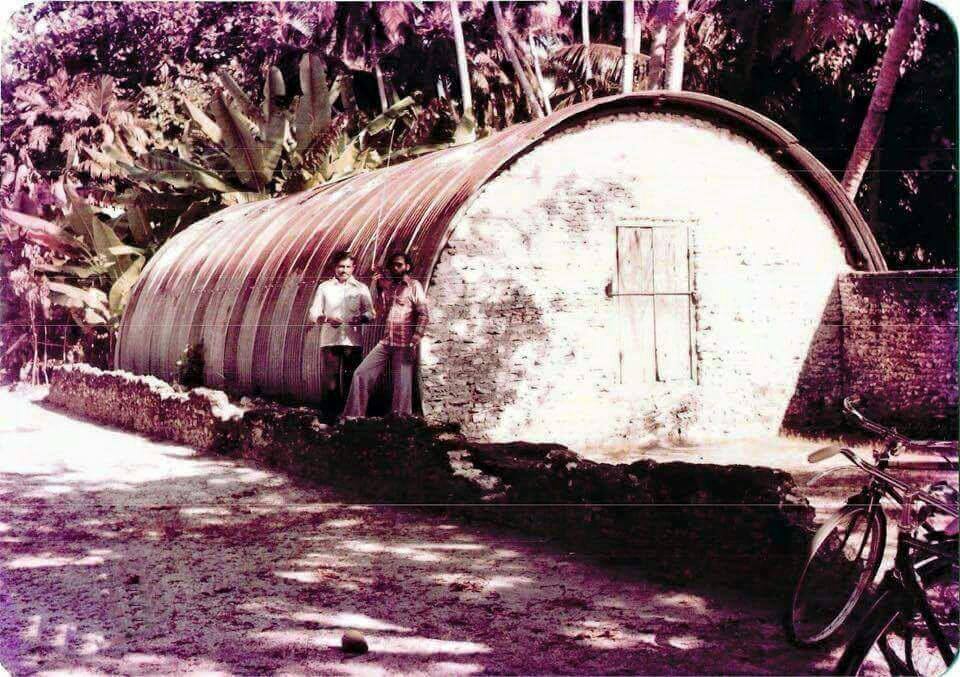 Boanuge was used mainly for storage in the Maldives. In the second World War, the huts were also used for living quarters, mess and hospitals. War time tropical boanuge had a raised area at the top though this type was not seen in the Maldives. They are usually 16, 20, 36 or 40 feet wide though other sizes were possibly used. This photograph is of one in Addu. Can you tell how wide it is? The photograph was from the FB page, Vonadhaana Raajje.
Boanuge was used mainly for storage in the Maldives. In the second World War, the huts were also used for living quarters, mess and hospitals. War time tropical boanuge had a raised area at the top though this type was not seen in the Maldives. They are usually 16, 20, 36 or 40 feet wide though other sizes were possibly used. This photograph is of one in Addu. Can you tell how wide it is? The photograph was from the FB page, Vonadhaana Raajje.
Odiharuge where boats are built.
Source: Black and white photo: Ali Akbar Flickr account. Colour photo: Dynamsf Twitter account.
Faalan (hiyaakuri). A sheltered jetty. Most islands have them. However, sheltering the jetty from rain and sun is rare. The one shown is Bodu Faalan or Big Jetty built during the time of President Ameen. It was featured in the first 2-Rufiyaa bank note because of its architectural significance. The faalan was dismantled later.
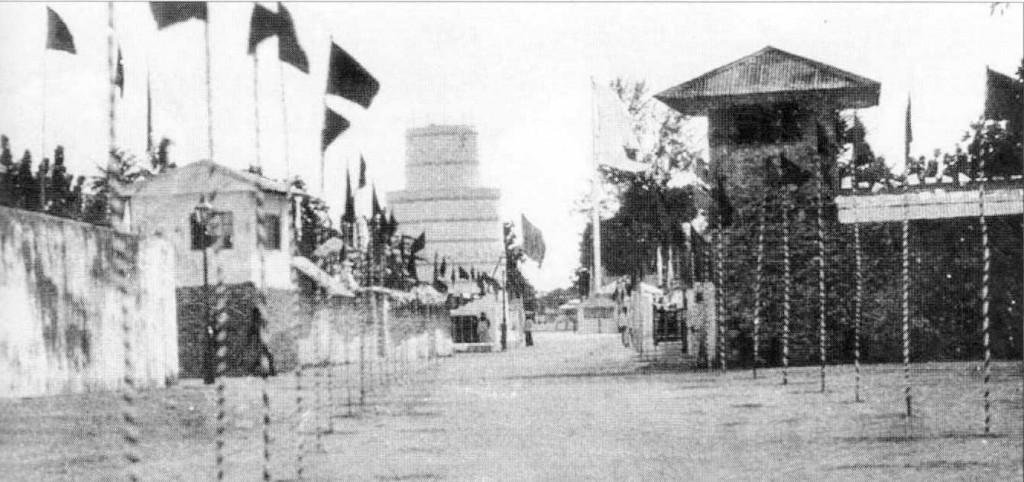 Kulhibalaage is a sheltered and raised room or platform on which womenfolk stand to watch street events. In the photo, the tall structures on either the side of the street are kulhibalaage. The kulhibalaage can be the top storey of a two-storey structure.
Kulhibalaage is a sheltered and raised room or platform on which womenfolk stand to watch street events. In the photo, the tall structures on either the side of the street are kulhibalaage. The kulhibalaage can be the top storey of a two-storey structure.
Maizan a gathering place for the district (ward) public. The photo on the left shown the Maizaange of Henveyru ward. The one on the right belongs to Machchangolhi. These small buildings have hipped roofs. Source: http://books.novelty.com.mv/library/downloads/dhivehidigest23.pdf
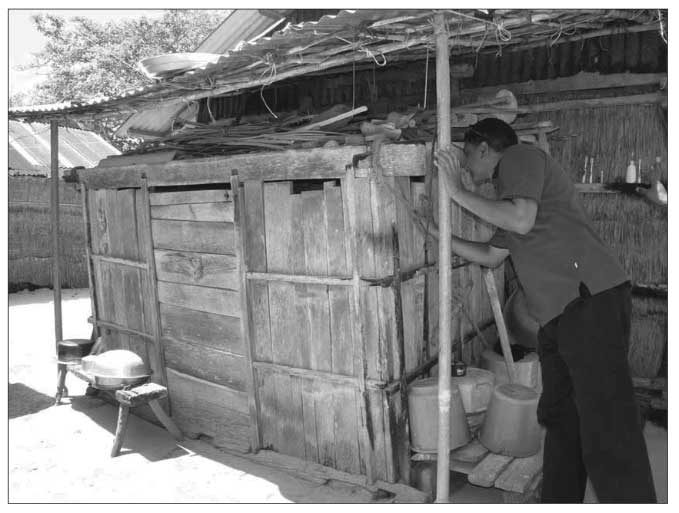 Koshaaru is a store for grains (granary) or other goods. They are sometimes raised from the ground. The doorway is shut by inserting a number of slats into grooves of the door jambs. Only the topmost slat is locked. Colour photos of koshaaru are on internet (e.g. https://laafenn.wordpress.com/tag/fables/).
Koshaaru is a store for grains (granary) or other goods. They are sometimes raised from the ground. The doorway is shut by inserting a number of slats into grooves of the door jambs. Only the topmost slat is locked. Colour photos of koshaaru are on internet (e.g. https://laafenn.wordpress.com/tag/fables/).
The above photo from:http://books.novelty.com.mv/library/downloads/dhivehidigest30.pdf
Construction of Temporary Huts
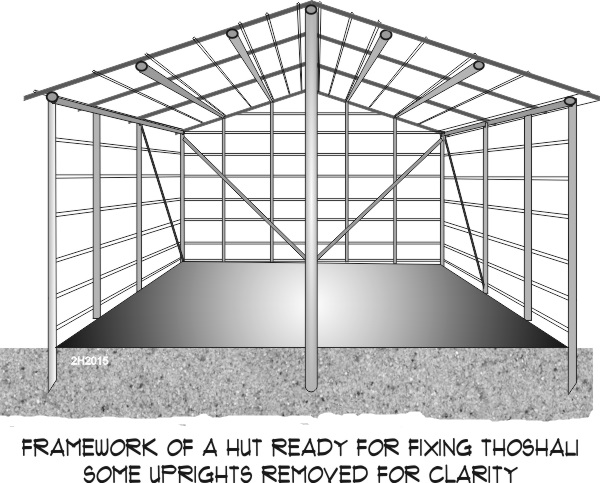 Temporary huts, such as ban’daha are made of tree branches and boughs. The huts are around 16 feet wide by 27 feet long. Coconut timbers are never used as they are hardy and dressing them is complicated. Wood from coastal forest trees, such Thespesia populnea, is usually used instead.
Temporary huts, such as ban’daha are made of tree branches and boughs. The huts are around 16 feet wide by 27 feet long. Coconut timbers are never used as they are hardy and dressing them is complicated. Wood from coastal forest trees, such Thespesia populnea, is usually used instead.
One construction practice worthy of note is that the roof and sides are covered with a thinner covering of woven coconut leaves called thoshali. Thoshali is not used in more permanent shelters. The diagrams below show the general construction practices.
Thoshali is usually woven from untreated coconut leaves which discompose in the humid environment of the Maldives within a year. Coir ropes are used for binding the poles, branches and thoshali. The following diagrams show how thoshali is woven. The diagrams can be enlarge by clicking them.
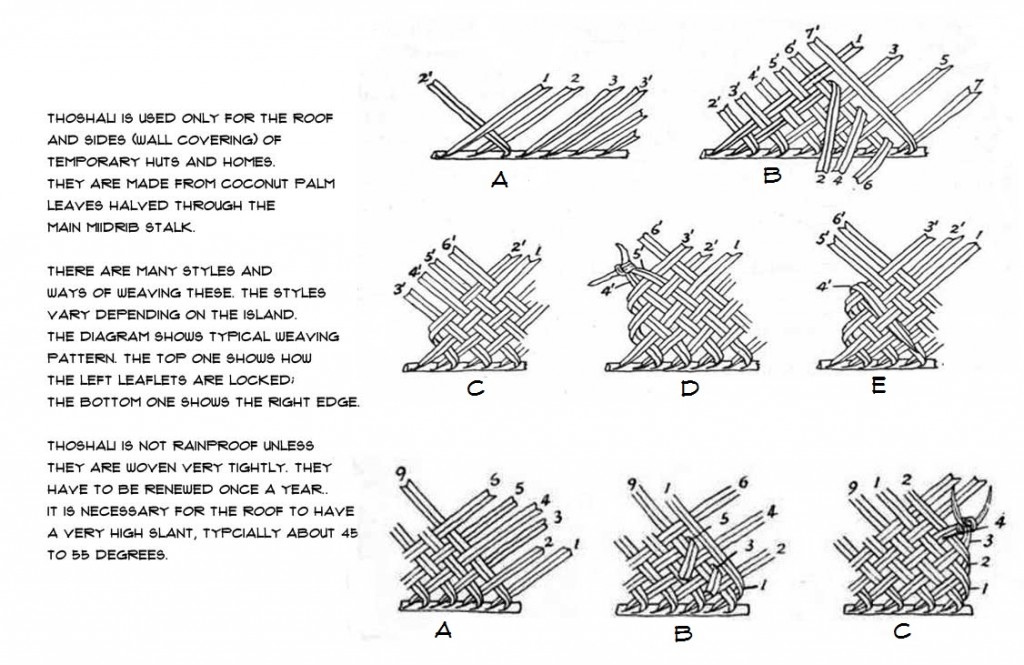
Double weaving of thoshali is shown below. It can be made from a single leave by bending the opposite side leaflets.
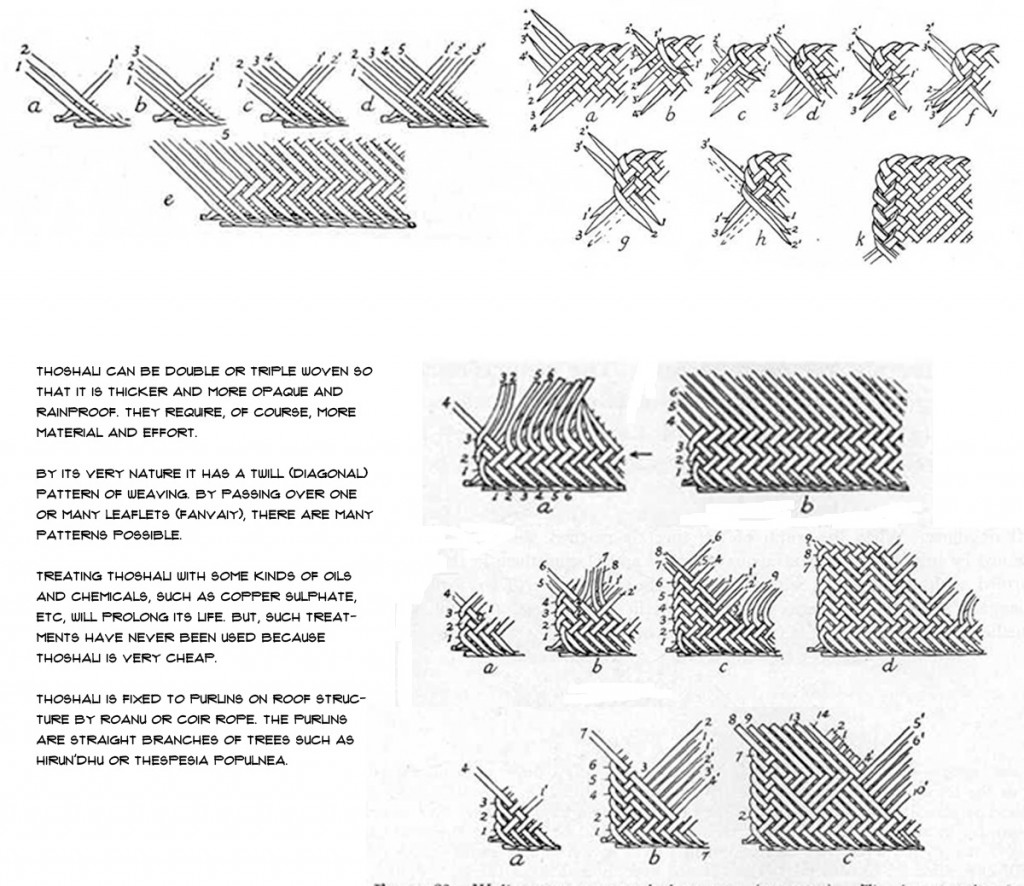
The covering for the ridge is specially made. The following diagrams show the process.
If you, the reader, could think of other shelters, please name them so that they could be included. Alternatively, if you can take more detailed photos in your visits to the rural islands, do send it for inclusion. Due reference will be given to you.
In Part 4, the design and construction of more permanent houses are discussed.

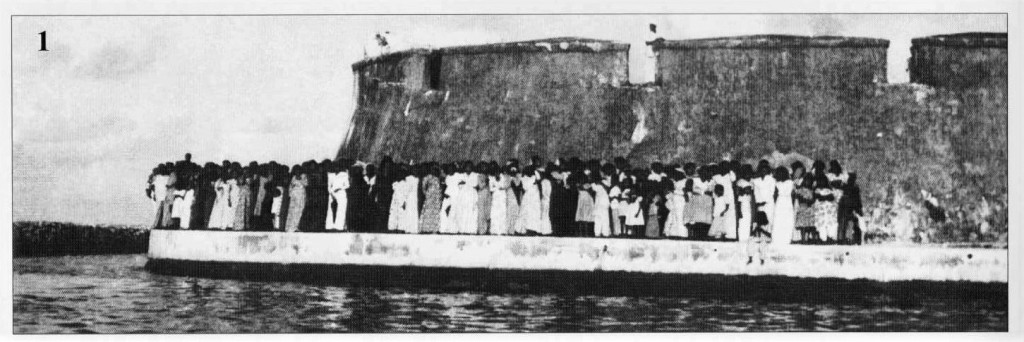
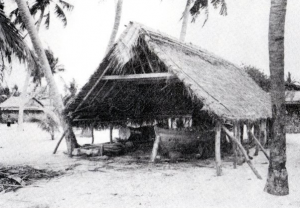
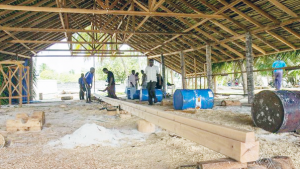
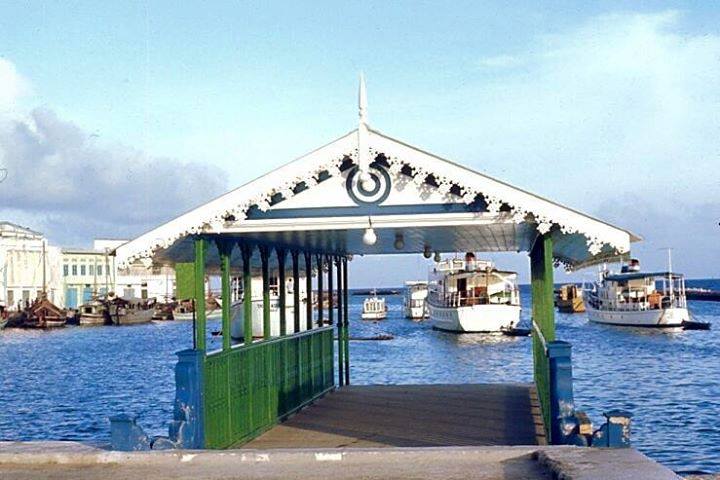
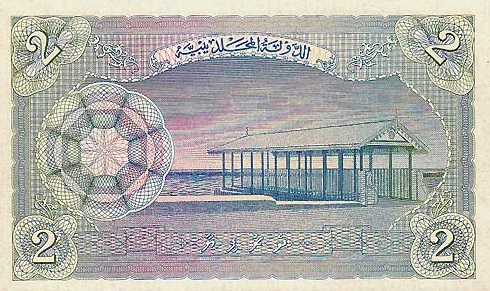
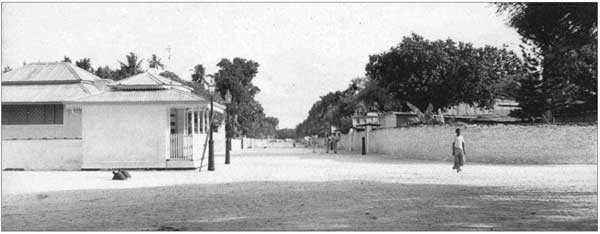
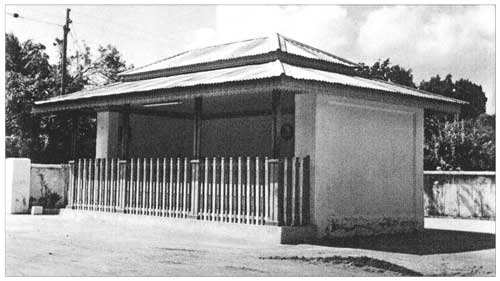
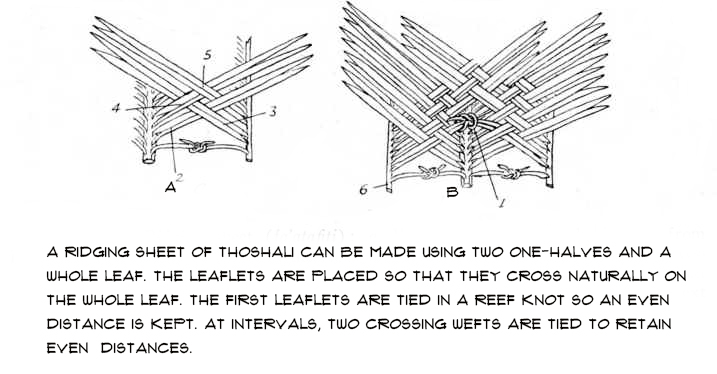
Hello Dr. Hassan. I am an Architecture student currently doing my degree. I have been trying to research more about the traditional housing of Maldives and can’t seem to find a lot about it. The information you have shared has been a great help so far.
I was wondering where i can find the Part 4 the design and construction of more permanent houses? I can’t find it on your website.
Best wishes
where can i get this book
Novelty Bookshop, Fareedhee Magu, Male’
Science Resource Unit, Education Development Centre, Male’
Hi..
We are trying to build a replica of a maldivian village and would like to sit down and discuss about the project..
would like to ask for an appointment if possible
thank you
dear Dr. Hassan
My name is Bernardo i am a portuguese and i leave in maldives.
Was very refreshing all the informations on your website, special all the info about ancient maldivian architecture.
i would like to know if besides the books you suggest there are any more info about it .
there are still someone that knows still how to buildthem?
with best regards
thank you so much for your work
Dear Bernado,
Thank you for your comment and interest.
There has been a recent book about coral stone mosques of Maldives by Mauroof Jameel.
See: https://www.facebook.com/Coral-Stone-Mosques-of-Maldives-765085686999608/
As architectural hard-bound books are not cheap, price may not be regular.
There may be some people who know how to build local homes still living. But, this knowledge may soon die out.
A more detailed response is possible if I would know your area of interest.
Best wishes